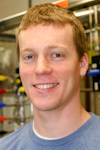
Jim Baker
taken from the University of Rochester's Research Connection,
August 8th Issue
Jim Baker, a Ph.D. student in Physics, is working with Benjamin
Miller Ph.D., Professor of Dermatology and of
Biochemistry & Biophysics, to develop optical biosensors small enough and sensitive enough to detect
individual viruses or virus particles
that are only one ten-millionth of a meter in size.
If somebody is treated for a virus, we currently have no way to tell if somebody is completely cured of that
virus,
Baker explained.
You need a diagnostic sensitive enough to detect a single virus particle, which doesn't exist.
Baker's project is to develop just such a diagnostic. He is working on two-dimensional photonic crystal
(2DPhC) sensors -- micron-scale devices
that are fabricated in silicon and are so small you could fit 74,000 of them on a dime
,
Miller noted.
When we pass light through one of these sensors, it traps light of a particular color,
Baker said. When a
virus binds to our sensor, it changes the
color of light that can be trapped, and that allows us to detect if a virus is present.
Not surprisingly, these sensors are extraordinarily difficult
to design, Baker noted,
requiring computer simulations showing what color
of light is trapped by various geometric patterns, and how the binding of a virus changes that. This generates a
large volume of results -- all related, yet all
different and needing to be analyzed together,
Baker said. It was a significant challenge at first to
analyze all of these different data sets separately,
while trying to keep them all in mind so I could draw global conclusions.